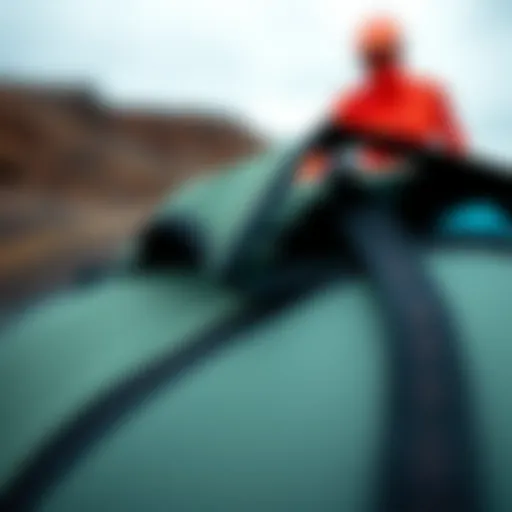Windsurfing in Myrtle Beach: A Comprehensive Guide
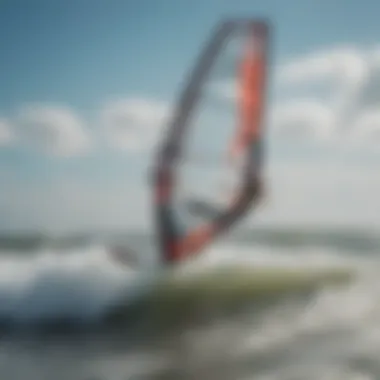

Intro
Myrtle Beach is a gem on the East Coast, not just for its golden sands and vibrant nightlife but for its exhilarating windsurfing scene. With the Atlantic winds caressing the shoreline and warm waters inviting enthusiasts, it’s no surprise the area has become a hotspot for both novice riders and seasoned pros.
Windsurfing here isn’t merely a sport; it’s a lifestyle that intertwines with the local culture. The winds can range from gentle breezes for beginners to challenging gusts for the experienced; such dynamics keep every ride fresh and exciting. Whether you’re looking to carve out waves or simply enjoy a leisurely glide across the water, Myrtle Beach has something to offer.
This piece isn’t just an overview; it’s a deep dive. From the evolution of windsurfing equipment over the years to the essential skills for riding the waves safely, this guide aims to connect with everyone involved in the windsurfing community. You’ll find practical insights on gear, methods, and crucial safety measures, as well as an exploration of local environmental nuances.
By the end, you’ll have a comprehensive understanding of what it takes to thrive in the exciting world of windsurfing, along with an appreciation of the community that surrounds this unique sport.
Surf Gear and Equipment
To hit the waves properly, you need to know the essentials of windsurfing gear. Not just any board or sail will do—you need the right equipment tailored to your skill level, conditions, and riding style.
Latest Surfboard Technologies
The surfboard is the cornerstone of any windsurfing experience. Recent advancements have led to lighter materials and more efficient designs. Modern boards often feature materials like carbon fiber, which offer durability without the extra weight. Some top models now boast adjustable fin systems, allowing you to change your configuration based on both wind conditions and water state. Brands like Naish and Starboard are known for pushing the envelope in performance and craftsmanship, providing boards that are agile and responsive.
When selecting a board, consider your skill level. For newbies, wider boards provide stability, while advanced riders might seek out narrower shapes for speed and maneuverability. Coupled with the right sail, these boards can help you harness the wind like a pro.
Essential Accessories for Surfers
Accessories are crucial in ensuring that your windsurfing journey is not just successful but also enjoyable. Here’s a rundown of must-have accessories:
- Harness: A good harness frees your arms and gives you better control over the sail. Look for comfortable fits that allow for movement and flexibility.
- Wet Suit: Depending on the time of year, a wetsuit can keep you warm while providing protection from the sun and scrapes.
- Leash: Never underestimate the importance of a leash. It keeps your board close, especially in turbulent conditions.
- Impact Vest: For added safety, an impact vest offers crucial buoyancy and helps absorb shocks during falls.
All of these tools complement one another, forming a package that turns your grooming from a mere hobby into a thrilling sport.
"The right gear not only enhances performance but also opens the doors for safer and more enjoyable experiences on the water."
Techniques and Skills
Windsurfing is about more than just having the right gear; it’s an art that combines technique, body awareness, and an understanding of the wind. Developing your skills in these areas can transform your time on the water.
Wave Riding Strategies
To ride waves effectively, you need to read the water. Understanding the flow and the tempo of the ocean is half the battle. Start by practicing on smaller waves before progressing to bigger swells. Riding the face of the wave involves balancing your weight and knowing when to lean in or pull back. Advanced maneuvers, like jumping or cutting back, require practice, but the thrill of mastering a wave is exhilarating.
Safety and Surf Etiquette
Safety is paramount in any water sport, and windsurfing is no different. Always be aware of your surroundings and follow these basic codes:
- Check Conditions: Before heading out, assess the wind and tide conditions. It’s better to miss a day than to face dangerous weather.
- Keep Distance: Maintain a good distance from other surfers. Collisions can be dangerous; a little space goes a long way.
- Signal: Use hand signals to communicate with others if you need to change direction or alert someone to a potential danger.
This etiquette reinforces respect among surfers and helps cultivate a friendly environment for everyone involved.
In summary, windsurfing in Myrtle Beach offers a blend of thrill, community, and respect for nature that few other sports can match. With the right gear, techniques, and mindset, you can ride the winds and waves like a true local.
Prolusion to Windsurfing
Windsurfing isn't just a sport; it’s a blend of adrenaline, skill, and interaction with nature that captures the spirit of the ocean like few other activities. In the vibrant setting of Myrtle Beach, this thrilling endeavor offers unique opportunities for both seasoned athletes and newcomers. This article aims to showcase the full spectrum of windsurfing here, from its rich history to the specific gear required for an optimal experience.
Historical Context
To understand windsurfing is to know its roots. The sport has a fascinating history that traces back to the late 1960s when it evolved from traditional surfing. A couple of inventive surfers in California began experimenting with a sail mounted on a surfboard, allowing them to harness the wind for added propulsion. This revolutionized surfing, and soon, windsurfing gained rapid traction around the world.
Now, activities like windsurfing in Myrtle Beach are not just linked to fun but also represent a vibrant community that pours creativity, passion, and technique into the sport. Over the years, windsurfing has seen a mix of innovation in gear and technique—turns, jumps, and tricks have developed in tandem with advancements in equipment designs.
Fundamentals of the Sport
Whether you're standing on a board for the first time or a seasoned pro, the basics of windsurfing remain critical. At its core, windsurfing combines elements of surfing and sailing, regulated by the wind, waves, and skill of the windsurfer. Here are the core components:
- The Board: This is where you stand. Boards come in different shapes and sizes, affecting stability and performance.
- The Sail: Critical for capturing wind, sails vary in size and shape based on conditions and rider preferences.
- The Rigging: This refers to how the sail is attached and positioned on the board. Proper rigging is essential for maximizing wind efficiency.
Learning to windsurf typically involves mastering balance on the board, steering with your body, and understanding how to trim the sail for optimal propulsion. As you progress, you’ll find that controlling the wind's power takes both technique and intuition—skills honed over time.
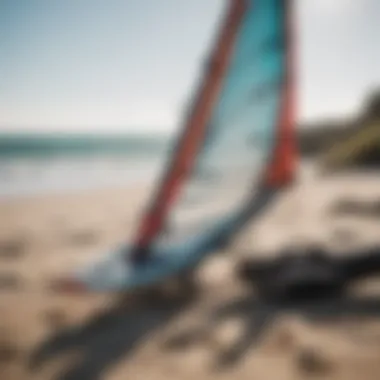

Windsurfing in Myrtle Beach offers a blend of wind and water conditions that can suit diverse skill levels. Learners can start in calmer seas with lighter winds, gradually working their way up to catch bigger waves and stronger breezes. All in all, the basics forge the foundation of what can become a life-long passion for many!
Myrtle Beach as a Windsurfing Destination
When one contemplates the perfect backdrop for windsurfing, Myrtle Beach stands out as a veritable jewel. Nestled along the southern coast of South Carolina, this vibrant locale offers a unique blend of factors that make it an attractive choice for windsurfers of all skill levels. The prevailing winds, coupled with expansive sandy shores, create an ideal environment not just for the seasoned pros, but also for beginners eager to catch their first gusts. Each year, a slew of windsurfing enthusiasts flock here, drawn by the promise of exhilarating rides across the Atlantic.
Geographical Advantages
Myrtle Beach is surrounded by an assortment of geographical features that serve to enhance the windsurfing experience. The long stretches of beach provide ample room for both launching and landing, which is essential for a sport that thrives on movement. Unlike many locations that may be hampered by rocky coastlines or urban development, Myrtle Beach boasts a vast sandy expanse, allowing for easier access to the water.
The proximity to the ocean means that wind patterns are usually quite favorable. Frequent onshore and offshore breezes create diverse conditions that cater to a range of skill levels. Beginners learning the ropes can practice in lighter winds, while more experienced windsurfers can challenge themselves with gustier conditions further offshore.
Additionally, the nearby marshlands and inlets provide natural protection from harsh winds, creating a more controlled environment for practice while still capturing the thrill of the ocean. It's like having multiple playgrounds right at your fingertips, each suited for different types and styles of windsurfing.
Climate and Seasonality
The climate in Myrtle Beach amplifies its status as a sought-after windsufing destination. With a mild subtropical climate, the area enjoys warm temperatures that make it conducive for year-round windsurfing. Summers are particularly enjoyable, with average temperatures ranging from the mid-70s to the low 90s Fahrenheit. The ocean temperatures hover around a cozy 70 degrees, making it inviting enough for most paddlers.
However, windsurfing isn’t just a warm-weather venture here. Spring and fall offer excellent winds that attract enthusiasts eager for that crisp, clear air. Each season presents its own array of advantages; for instance, the spring brings consistent winds that are just right for honing skills or setting the stage for competitions, while fall provides a more tranquil time to enjoy casual rides along the beach.
In addition to seasonal shifts, local weather trends play a pivotal role in planning excursions. Checking the forecasts regularly allows windsurfers to pick the perfect days to hit the water, ensuring maximal enjoyment while minimizing frustrations.
"Myrtle Beach is like a windsurfing buffet—there's something for everyone, every season!"
In summary, Myrtle Beach is a windsurfer's paradise clad in natural beauty and welcoming conditions. Its geographic and climatic advantages not only enhance the thrill of the sport but also create a community that cherishes the harmony between adventure and nature.
Understanding Wind Patterns
Understanding wind patterns is crucial for both beginners and experienced windsurfers. It can make or break your experience on the water. Windsurfing relies heavily on the interplay between the wind and the water, and if you're not tuned into local wind dynamics, you might find yourself struggling or, worse, in unsafe conditions. The ability to read these patterns can significantly enhance performance and safety, providing a foundation for truly enjoying the sport.
Local Wind Dynamics
Myrtle Beach sees a variety of wind conditions influenced by geography and oceanic elements. What stands out here is the daily sea breeze—winds often fill in from the ocean during the day as the land heats up faster than the sea. This phenomenon is perfect for those who are learning because it tends to create consistent wind conditions in the afternoons, making it a reliable time for practice.
However, it's not just the sea breeze that influences the local conditions. You also have to consider how coastal features like jetties and dunes affect wind flow. These natural structures can channel winds, creating gusts in some areas and calm patches in others. So, understanding where to setup is key.
Alicia, a local windsurfer, shares her experience:
"Learning to read the wind here was like learning to dance. At first, it can be all over the place, but once you start to recognize the signals, it feels like second nature."
It pays to pay attention to local weather forecasts, but, just like in fishing, instincts and experience will guide you as you become more familiar with the whims of the Myrtle Beach wind patterns.
Optimal Wind Conditions for Beginners
So, what should a beginner look for? Here are some optimal wind conditions that many find suitable for starting out in windsurfing:
- Wind Speed: Ideally, winds between 10 to 15 knots are perfect for beginners. They offer enough power without being overwhelming.
- Wind Direction: Onshore winds are most favorable for novices since they push you back toward the safety of the shore.
- Water Conditions: Flat waters are preferable for learners. They reduce the risk of falling and help with balance—something that is essential when getting your bearings on the board.
For those starting out, a helpful tip is to observe the more experienced windsurfers. Not only does this allow you to gauge controls, but you'll also notice how they choose their spots according to these factors. This not only bolsters your learning but also enriches your appreciation for what makes windsurfing truly enjoyable.
In summary, understanding wind patterns is a journey worth undertaking. It connects you to the elements, honing skills that go beyond just riding the waves. Get familiar with the local dynamics, and you will find that windsurfing can be as liberating as it is exhilarating.
Essential Gear for Windsurfing
When it comes to windsurfing, having the right gear isn't just a luxury; it's essential for safety, enjoyment, and performance on the water. Gleaming boards and colorful sails fluttering in the breeze are more than just eye candy—they're key facilitators of your wet and wild adventures. Choosing the proper equipment allows you to approach the sport with confidence, whether you are a novice eager to catch your first wave or a seasoned pro aiming for that next big trick.
Types of Boards and Sails
Selecting the right board and sail pair can significantly impact your windsurfing experience. It's much like picking the perfect dance partner; the chemistry has to be just right.
- Board Types
- Sail Types
- Freestyle Boards: Compact and light, designed for tricks and spins. They allow for high maneuverability, making them a favorite for those looking to impress.
- Freeride Boards: General-purpose boards made for cruising and speed. They work well in various wind conditions, perfect for those enjoying the journey more than just the destination.
- Slalom Boards: Built for blistering speed, these are ideal for those serious about racing. Longer than freeride boards, they require more skill to control.
- Wave Boards: Shorter and thicker, these are made for surfing on waves and handle choppy waters with ease, appealing to those who enjoy a thrill.
- Mast Size: The size of your mast will dictate the wind range you can handle. A bigger mast means more control in strong winds but can be tricky for beginners.
- Sail Shape: Sails come in different shapes – flat sails for speed, and fuller sails for power. Consult with local experts about what shapes work best in Myrtle Beach conditions.
- Materials: Look for sails made from durable materials that ensure longevity. Dacron is common for recreational sails, while high-performance sails often use monofilm.
When picking out your board and sail, think about your skill level, preferred wind conditions, and the style of windsurfing you want to pursue. Adjustability is another factor to consider; look for gear that can grow with your skill set.
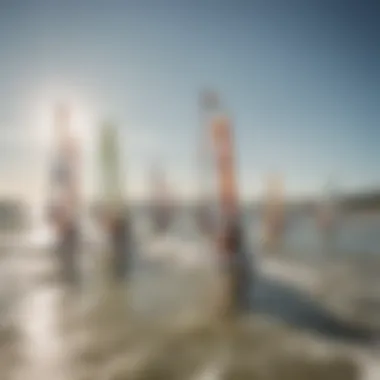

Safety Equipment and Accessories
Safety can't be taken lightly when you are harnessing the power of the wind. Windsurfing can be thrilling, but it also can be unpredictable. Here are some crucial items to make sure you stay safe while enjoying your time on the water:
- Personal Floatation Device (PFD): Wearing a PFD is a must. It provides essential buoyancy, ensuring you stay afloat if you end up in the drink unexpectedly.
- Safety Leash: Attaching a safety leash to your board keeps your equipment close even if you wipe out. This prevents you from having to swim back for your gear, which can be a tall order in rough waters.
- Helmet: A good helmet protects your noggin from unexpected bumps and falls, especially when you're just learning the ropes or pushing your limits.
- Sunscreen and Sunglasses: Don't skimp on protection from the sun's harsh rays. Choose a good, waterproof sunscreen and a pair of sunglasses with straps to protect your eyes while riding the waves.
- Wetsuit or Rash Guard: Depending on the season, a wetsuit keeps you warm in cooler waters. A rash guard, on the other hand, helps prevent skin irritation and sunburn during those longer sessions.
Being prepared is half the battle. Equip yourself with the right accessories so that you can enjoy windsurfing without any unnecessary worries.
"The only bad windsurfer is the one without proper gear."
Understanding the importance of your equipmnt is the first step to becoming an adept windsurfer. Investing in quality gear tailored to your style will not only enhance your skills but also increase your enjoyment on those stunning Myrtle Beach days. Whether it’s the gear you choose or the accessories you pack, sailing through the waves is about creating unforgettable experiences.
Windsurfing Techniques
Windsurfing is not just about gliding on the water; it’s an intricate dance between wind, water, and the sailor’s skills. As you delve deeper into the sport, you’ll discover that mastering various techniques can open up a world of possibilities, enhancing both performance and enjoyment. In this section, we will break down the essential maneuvers and advanced techniques that every windsurfer needs to know, each contributing to a richer experience in the vibrant waters of Myrtle Beach.
Basic Maneuvers
Understanding basic maneuvers is akin to learning to walk before you run. For beginners, these foundational skills provide the bedrock upon which you can build more complex techniques later on. Here are some key maneuvers:
- Sail Power Management: Learning to control the sail is essential. By shifting your weight and adjusting the angle of the sail, you can harness the wind effectively.
- Tacking: This maneuver involves turning the board into the wind, which helps you change direction. It’s simpler than it sounds; all it requires is practice and a bit of timing.
- Jibing: Similar to tacking but done with the wind at your back, jibes enable smooth transitions which are critical for maintaining speed and control.
- Uphauling: Getting back up on the board after a fall can be tricky. Practice uphauling the sail swiftly, as it's a vital skill that saves time and energy during your session.
Mastering these basic skills not only boosts confidence but also enhances safety on the water. Think of it as your windsurfing toolbox. Once you have these basics down, shifting to more advanced techniques becomes a natural progression.
Advanced Techniques
Once you’ve got the basics nailed down, it’s time to push your limits and explore some advanced techniques. Delving into these techniques can take your windsurfing to new heights.
- Footstraps: Using footstraps effectively allows you to transfer your weight efficiently while improving control over the board in higher winds. When you get comfortable, try fastening your feet to the straps instead of just relying on your balance.
- Carving Turns: This involves leaning into your turns to gain speed and agility. It’s a skill that profoundly impacts your maneuverability and overall performance.
- Sailing Upwind: Learning advanced sailing angles can enable you to head directly into the wind. This technique requires skill in managing sail trim and board angle; it opens up routes to explore that flat out broaden your windsurfing experience.
- Aerial Jumps: For the exhilarated soul, aerial tricks can add flair to your windsurfing sessions. Perfecting jumps requires practice to avoid wipeouts, but the thrill of catching air is a reward like no other.
Engaging in these advanced maneuvers not only leads to a more exhilarating ride but also cultivates deeper engagement with the windsurfing community. At events, advanced techniques such as aerial stunts are often the highlight, garnering admiration and excitement from spectators and fellow surfers alike.
"The beauty of windsurfing lies not just in the speed and thrills but in the moments of learning and mastering each technique along the way."
As you develop your windsurfing techniques, remember that practice is key. Each run on the water is an opportunity to refine your skills and connect with the vibrant culture of windsurfing in Myrtle Beach.
Community and Culture of Windsurfing in Myrtle Beach
Windsurfing is more than just a sport; it’s woven into the fabric of Myrtle Beach’s coastal lifestyle. The local community plays a vital role in fostering a culture that attracts both enthusiasts and newcomers alike. This community spirit is seen in the friendship that develops through shared experiences on the water and collective participation in local events and institutions.
Myrtle Beach offers a unique blend of warmth and inclusivity, showcasing its charm through various clubs and schools dedicated to windsurfing. These gatherings not only provide practical training and support but also serve as a platform for forging lifelong connections. There’s something invigorating about sharing the salty breeze with others who share the passion for harnessing the wind.
Local Windsurfing Schools and Clubs
When it comes to getting into windsurfing, Myrtle Beach boasts numerous schools and clubs that cater to all skill levels. Whether you’re a curious beginner wanting to dip your toes into the sport or a seasoned sailor looking to refine your skills, there’s a place for you. Clubs like Myrtle Beach Windsurfing School offer comprehensive lessons that cover everything from the basics to advanced maneuvers. Here, experienced instructors take on the vital task of not just teaching techniques but also instilling confidence in their students.
Joining a local windsurfing club not only enhances one’s skills but also opens the door to a plethora of social opportunities. Members often organize regular meetups for casual windsurfing sessions and exchange tips with each other, creating a collaborative environment.
Moreover, these clubs frequently hold workshops, which cover a range of topics, including maintenance of equipment, understanding wind patterns and safe practices on the water.
Events and Competitions
Local events and competitions are central to building the windsport culture in Myrtle Beach. These gatherings serve as a rallying point for the community, bringing together a mix of amateurs and professionals. Events like the Myrtle Beach Windsurfing Festival draw crowds and participants from far and wide, turning a regular day of windsurfing into an electrifying spectacle.
Competing not only provides windsurfers a platform to showcase their skills but also promotes camaraderie among participants. It's common to see competitors cheering each other on, regardless of their standings. Participating in these events fosters a sense of belonging, as both competitors and spectators share in the thrill of the races.
Network opportunities abound in such events, with seasoned surfers sharing insights with newcomers.
"Windsurfing in Myrtle Beach is not just about riding the wind; it’s about riding the wave of a shared experience, one friendship at a time."
Connecting with others at events can spark both new friendships and mentorships, enriching one’s journey in this exhilarating sport. In essence, the community and culture surrounding windsurfing in Myrtle Beach not only bolster individual skills but also create a tight-knit environment that celebrates the essence of this thrilling sport.
Environmental Considerations
Exploring the world of windsurfing in Myrtle Beach not only showcases thrilling activities but also brings into sharp focus the environmental considerations tied to this vibrant sport. Windsurfing, while exhilarating, can have significant effects on local ecosystems. Understanding these implications is crucial for both novice and experienced windsurfers alike. It drives home the importance of safeguarding our natural surroundings so that future generations can enjoy these water sports in pristine conditions.
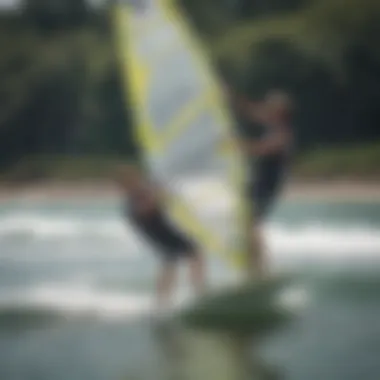

Impact of Windsurfing on Marine Ecosystems
Windsurfing utilizes large volumes of ocean space, and every so often it interacts directly with marine life. Heavy use of certain spots can lead to disturbances. For instance, repeated traffic over specific areas might affect the habitats of marine creatures such as fish or delicate coral formations. The vibrations of boards and sails can stress aquatic species or alters the natural behavior of local fauna.
This intersection of sport and nature necessitates careful management. When windsurfers engage in high-traffic areas, they should consider timing their fun to avoid sensitive breeding seasons for certain species. This way, all participants – be it surfers or wildlife – can thrive. A little awareness goes a long way in preserving Myrtle Beach's rich marine biodiversity, increasing both enjoyment and sustainability.
"A community that appreciates their environment is one that flourishes alongside it."
Sustainable Practices for Windsurfers
Engaging in windsurfing doesn't mean one’s obligations towards maintaining ecological balance should fly out the window. There are several sustainable practices that can be adopted. To start, windsurfers should:
- Choose Equipment Wisely: Opt for equipment made from eco-friendly materials. Many brands now offer boards and sails that are designed with sustainability in mind.
- Be Conscious of Nature: Stick to designated windsurfing areas and respect wildlife zones. Avoid areas known for sensitive ecological habitats.
- Participate in Clean-Ups: Hands-on engagement counts. Join local clean-up events or organize your own community efforts to collect trash from the beaches.
Moreover, educating fellow windsurfers on the significance of preserving natural surroundings can amplify the impact. Share insights on how to protect the coastal locations while enjoying the sport. Small actions, when multiplied by a community, can lead to substantial improvements in preserving the delicate balance between sporting fun and ecological sustainability.
Safety Protocols in Windsurfing
Windsurfing, while exhilarating, comes with its own set of risks. It’s critical to prioritize safety protocols to ensure that both novices and experienced riders can enjoy the sport to its fullest. Understanding and implementing safety measures can significantly diminish the chances of accidents, ensuring that the thrill of ride does not morph into a tragedy. For anyone engaging in windsurfing in Myrtle Beach, being equipped with the right knowledge and habits is a must for a safe and enjoyable experience.
Pre-Windsurfing Checklist
Before you hit the waves, a thorough checklist can be your best friend. It offers a practical way to prepare, ensuring nothing slips through the cracks. Here’s what to consider:
- Equipment Inspection: Check your board and sail for any signs of wear or damage. Cracks, loose straps, and other issues should be addressed before heading out.
- Safety Gear: Ensure you have your life jacket on and any other safety equipment you plan to use. It’s better to be safe than sorry—especially in windy conditions.
- Weather Check: Examine local weather forecasts. High winds and storms can change the landscape literally and figuratively. Make sure conditions are suitable for your skill level.
- Personal Notifications: Let someone know your plans. It's not just about being polite; it provides an added safety net should anything unexpected arise.
- Emergency Contact: Always carry a means of communication, such as a waterproof phone case, in case of emergencies.
- Know Your Limitations: Be honest with yourself about your skill level. It can be tempting to stretch boundaries, but safety should never come second.
"Being prepared is not just a convenience; it's the lifeline of safety in any sport."
Emergency Procedures
Even with the best preparations, emergencies can still happen. Knowing what to do in various situations can save lives and stabilize stressful moments. Familiarize yourself with these essential procedures:
- Capsize Protocol: In the event of a fall, remain calm and hold onto your board. Float with it, and avoid panicking.
- Identifying the Wind Direction: To lift your sail back up, you’ll need to ensure you know the wind’s direction. Understand how to position yourself to assist the recovery process.
- Rescue Signals: If you're unable to get back up, signaling for help is crucial. Learn the universal distress signal—waving your arms vigorously and remaining vocal can attract help.
- Reaching Shore Safely: If conditions deteriorate and you can manage to sail back to shore, do so calmly. Keeping your movements slow will conserve energy.
- First-Aid Knowledge: Familiarize yourself with basic first-aid practices, particularly in treating cuts, scrapes, or any potential injuries sustained during windsurfing.
- Know Local Rescue Services: Understanding who to call and what resources are available locally can make a real difference in emergencies.
Implementing solid safety protocols and being conscious of potential risks ensures a smoother and more enjoyable windsurfing experience in Myrtle Beach. Both newcomers and seasoned pros should never overlook these essential components.
Frequently Asked Questions
In any sport, especially one as dynamic as windsurfing, questions abound. The importance of addressing commonly asked questions cannot be overstated. These FAQs serve as a compass for both novices wanting to dive in and experienced individuals seeking a deeper understanding of the specificities involved in windsurfing at Myrtle Beach. Not only do they clarify uncertainties, but they also enhance preparedness, leading to a safer and more enjoyable experience on the water. The questions answered here illuminate many aspects, from identifying suitable conditions for beginners to the best timing for your windsurfing adventure.
Is Windsurfing Suitable for Beginners?
Windsurfing often seems daunting to newcomers. The blend of sailing and surfing requires a certain level of skill and balance, but the question remains: Is windsurfing really suitable for beginners?
Absolutely. Myrtle Beach stands out as an excellent location for those just beginning their windsurfing journey. The gentle winds and relatively calm waters create the ideal learning environment. Local schools often offer beginner classes, introducing newcomers to the core principles of the sport. In these sessions, participants learn about the basic gear, such as boards, sails, and safety equipment, while also getting acquainted with important techniques like balance and control.
Additionally, the local community is quite welcoming. New surfers will find camaraderie with experienced windsurfers who are typically eager to share their knowledge and tips. This environment not only fosters skill development but also encourages a sense of belonging among windsurfing enthusiasts. So, if you're curious about giving it a shot, rest assured, Myrtle Beach has your back!
What are the Best Times to Go Windsurfing?
Timing is everything, especially in windsurfing. Choosing when to hit the water in Myrtle Beach can significantly affect the experience. If you're contemplating, you'll find that generally, the best times to windsurf here are during the spring or early autumn months.
During these periods, the wind conditions are typically more stable and manageable. The months of April to June and September to October offer steady breezes that are not overly aggressive, catering well to beginners and allowing them to practice without the worry of harsh gusts. Also, the water temperatures remain inviting during these seasons, which promotes longer sessions without the chill.
On hotter summer days, winds can sometimes be too unpredictable, gusty, and strong, often challenging for novice surfers. For those advanced riders, these conditions might be favorable, but beginners should tread carefully. Being aware of these seasonal patterns can make all the difference in having a successful windsurfing outing, ensuring an exhilarating yet safe experience on the waves.
Ending
The conclusion of an article provides a vital recap and leaves readers with lasting impressions. In this exploration of windsurfing in Myrtle Beach, it's imperative to reflect on the various aspects discussed and how they interconnect. Windsurfing isn't merely a sport; it embodies a blend of adventure and environmental awareness, making it significant for both the individual surfer and the community.
Recap of Key Points
- Historical Context: Understanding windsurfing’s origins helps highlight its growth. From humble beginnings on the waters to becoming a global sport, the evolution is captivating.
- Myrtle Beach as a Destination: Its geographical location and favorable climate make it an ideal spot for both novice and experienced windsurfers.
- Understanding Wind Patterns: The local wind dynamics are crucial. They dictate the safety and enjoyment of the sport, especially for beginners.
- Essential Gear: Discussing suitable boards and sails is paramount—without the right equipment, windsurfing can be a struggle.
- Techniques: Basic and advanced maneuvers open up the world of windsurfing. Mastery of these can greatly enhance the experience.
- Community: The presence of local schools, clubs, and events fosters a welcoming environment for newcomers while building camaraderie among enthusiasts.
- Environmental Considerations: The balance between sportsmanship and environmental stewardship is crucial in maintaining the natural beauty of Myrtle Beach.
- Safety Protocols: Recognizing the importance of safety practices ensures that windsurfing remains an enjoyable and accident-free activity.
- Frequently Asked Questions: Addressing concerns and curiosities of new and seasoned surfers guides them in their windsport quests.
Future of Windsurfing in Myrtle Beach
Looking ahead, the future of windsurfing in Myrtle Beach seems promising. The continual growth in popularity can fuel more investments in infrastructure and better equipment.
- Newcomers will likely find more accessible classes and rental options.
- Increased focus on sustainable practices could preserve the coastal ecosystem while promoting windsurfing as an eco-friendly sport.
- With advancements in technology, equipment may become lighter and easier to handle. Think of the thrill—sailing smoothly over the water with fewer worries about gear getting in the way.
Community events and competitions are likely to increase as interest grows. This means more opportunities for both locals and tourists to engage with windsurfing, fostering a deeper connection with the sport and the stunning landscape that Myrtle Beach offers.
To sum it up, as windsurfing continues to build steam in Myrtle Beach, it not only enhances the local sports culture but also enriches the life experiences of anyone who takes to the water. As this article has shown, understanding the nuances of the sport can lead to more meaningful and enjoyable experiences on the waves.













